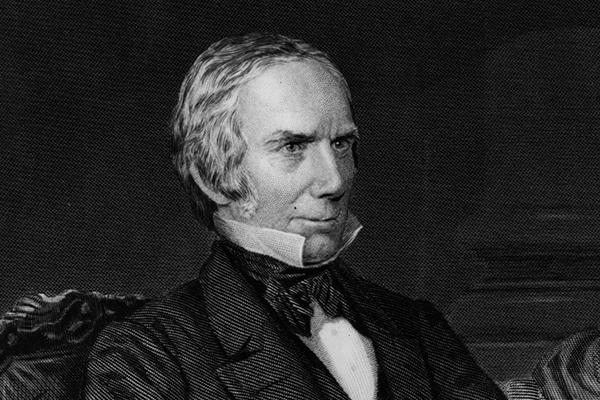Henry Clay’s defense of Aaron Burr from a politically motivated U.S. Attorney marked the start of his national political career, and the end of Burr’s.
When Aaron Burr resigned the vice presidency a few days before his term expired March 4, 1805, he faced murder charges in two states for killing Alexander Hamilton in a duel. He was a pariah in the East, hated even in his own Democratic-Republican party. But Westerners still appreciated him for his advocacy of Western interests in the 1790s, a new biography of Henry Clay by David S,. and Jeanne T, Heidler says.
Writing for AmericanHeritage.com in 2007, Jon Grinspan says Burr moved up and down the Ohio and Mississppi Rivers telling people he was preparing a “grand expedition.” He was accused of trying to separate the Western states and territories from the Union, or plotting an invasion of Spanish Mexico.
Burr’s Western Secession Conspiracy
Grinspan says Burr enlisted the support of Andrew Jackson, the British ambassador, and the military governor of Louisana for his secession scheme.
Grinspan writes that Great Britain’s minister to the United States, Anthony Merry, wrote to London that Burr asked for funding “to effect the separation of the Western part of the United States.” He said Burr even requested that the Royal Navy seize New Orleans during the takeover.
But Nancy Isenberg. in her 2007 biography of Burr, Fallen Founder, the Life of Aaron Burr, said Burr was merely using Merry’s dislike of the Jefferson administration to fund his effort to take land in Mexico, which was only a misdemeanor at that time.
Jefferson Calls Burr a Traitor
President Thomas Jefferson publicly called Burr a traitor before the third of Burr’s three trials for treason. Grinspan says Jefferson biased the investigation.
Grinspan agrees with Isenberg that most of the evidence of Burr’s treason is weak, “the product of ‘Burr fever’ that swept the West in 1806.” Newspaper reports and anonymous sources accused him of plotting to invade Washington D.C., raise an a Native American militia, and buy weapons from a corrupt U.S. Army fort.
Burr was tried and acquitted of treason three times, twice in Kentucky, once in Richmond.
Henry Clay Defends Aaron Burr
Henry Clay of Kentucky, then 29, was one of the prominent local figures Burr met for the first time in prosperous, cosmopolitan Lexington, Ky, the Heidlers say in their new Clay biography Henry Clay, The Essential American. Clay was a rising star in the Kentucky Legislature, already viewed by rich and poor as a good man, outstanding lawyer, deal-maker, and public speaker who was “going places.”
Federalists in Kentucky were a small, but active, well-connected minority, the Heidlers say. Newspaper owner Humphrey Marshall and U.S. Attorney Joseph “Jo” Daviess were both married to sisters of John Marshall, Chief Justice of the United States.
Marshall’s newspaper accused Burr of starting conspiracies in Kentucky, and Daviess sent a letter to President Jefferson saying Burr was assembling a conspiracy to detach the western states, and invade Mexico. The Heidlers say the list of conspirators Daviess sent the President was a virtual Who’s Who of Kentucky Republicans, including U.S. Attorney General John Breckinridge, U.S. District Judge Harry Innes, and Clay himself.
Burr and Clay’s First Grand Jury
In 1806, Marshall’s newspaperprinted stories of men assembling, boat construction, food stockpiles, and weapons purchases. Daviess traveled to Louisville to see for himself, and what asked Judge Innes to arrest Burr for plotting to invade Spanish Mexico, the Heidlers say.
Burr hired Clay to defend him. When the grand jury met, Daviess asked for a postponement because his star witness could not get there. Innes granted Daviess’s request for a second grand jury.
Senator Henry Clay
At first, Clay declined to represent Burr at the next grand jury. The Legislature had just elected him to fill an unexpired term in the U.S. Senate. Though he would only be a senator for three months, Clay was anxious to get there. Burr offered to pay Clay extra, and signed an oath saying he had never planned anything against the United States. Clay’s friends convinced him it would be dishonorable to abandon Burr, the Heidlers say.
At the second grand jury, Daviess asked for another postponement. Clay said another delay persecute Burr, not prosecute him. The newspaper editors admitted under oath they had no evidence of wrongdoing by Burr, the Seidlers say.
Clay Re-Assesses Burr
As Clay traveled east to take his Senate seat, he saw that Eastern Republicans, even President Jefferson, hated Burr as much as Federalists did. He began to wonder if Burr was innocent, and if he had ruined his national political career before it started by defending him, the Seidlers say.
In Washington, President Jefferson showed Clay a letter he said was “positive proof” of Burr’s treason. The Seidlers say many historians now doubt Burr had anything to do with the letter, but Clay was convinced Burr was guilty, and never forgave Burr for lying to him.
They did not see each other again until 1815, when they met by chance in New York City. Clay refused to shake his hand. When Burr asked for a private meeting, Clay told him where he was staying, but said nothing about a time or day. Burr did not visit, knowing Clay had not forgiven him, the Heidlers say.
Popular history long ago found Burr guilty of all charges. But these three recent scholarly investigations, while they don’t exonerate Burr, present a more balanced picture of Burr’s mysterious Western adventures.
Sources:
- Grinspan, Jon, “Did Aaron Burr Really Try to Take Over Half of America?” AmericanHeritage.com.
- Isenberg, Nancy, Fallen Founder: The Life of Aaron Burr, Viking, 544 pages, 2007
- Seidler, David S. and Jeanne T., Henry Clay: The Essential American, Random House, 593 pages, 2010








